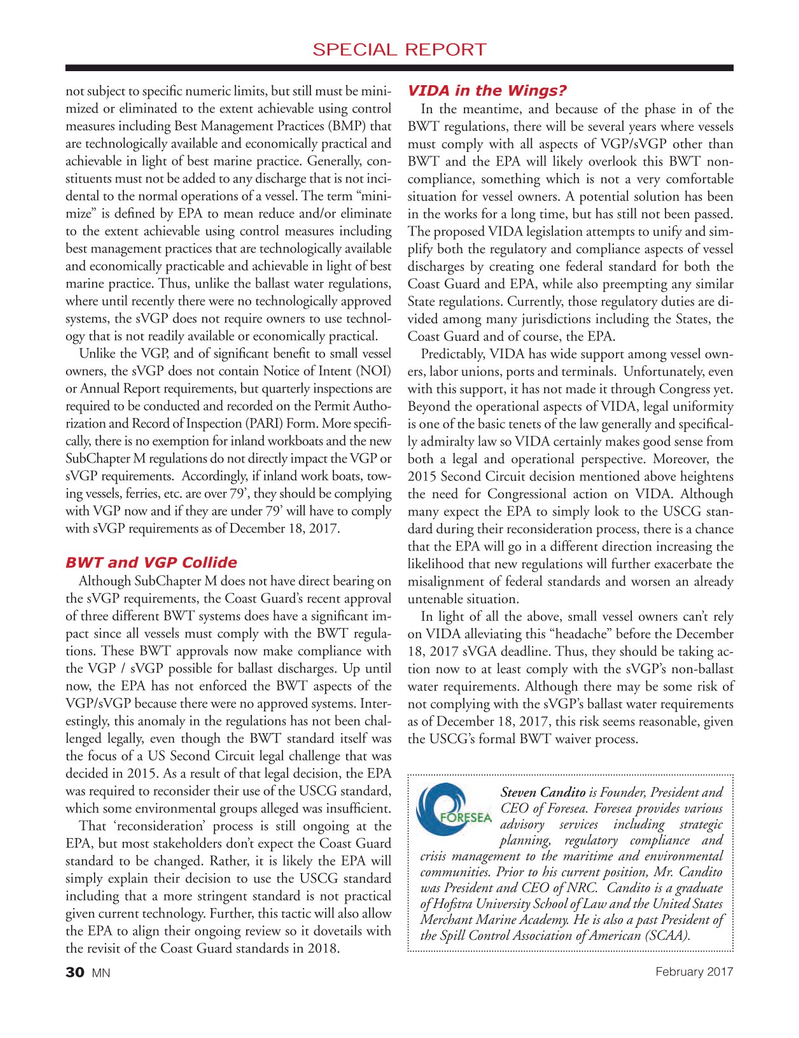
Page 30: of Marine News Magazine (February 2017)
Dredging & Marine Construction
Read this page in Pdf, Flash or Html5 edition of February 2017 Marine News Magazine
SPECIAL REPORT not subject to speci? c numeric limits, but still must be mini- VIDA in the Wings?
mized or eliminated to the extent achievable using control In the meantime, and because of the phase in of the measures including Best Management Practices (BMP) that BWT regulations, there will be several years where vessels are technologically available and economically practical and must comply with all aspects of VGP/sVGP other than achievable in light of best marine practice. Generally, con- BWT and the EPA will likely overlook this BWT non- stituents must not be added to any discharge that is not inci- compliance, something which is not a very comfortable dental to the normal operations of a vessel. The term “mini- situation for vessel owners. A potential solution has been mize” is de? ned by EPA to mean reduce and/or eliminate in the works for a long time, but has still not been passed. to the extent achievable using control measures including The proposed VIDA legislation attempts to unify and sim- best management practices that are technologically available plify both the regulatory and compliance aspects of vessel and economically practicable and achievable in light of best discharges by creating one federal standard for both the marine practice. Thus, unlike the ballast water regulations, Coast Guard and EPA, while also preempting any similar where until recently there were no technologically approved State regulations. Currently, those regulatory duties are di- systems, the sVGP does not require owners to use technol- vided among many jurisdictions including the States, the ogy that is not readily available or economically practical. Coast Guard and of course, the EPA.
Unlike the VGP, and of signi? cant bene? t to small vessel Predictably, VIDA has wide support among vessel own- owners, the sVGP does not contain Notice of Intent (NOI) ers, labor unions, ports and terminals. Unfortunately, even or Annual Report requirements, but quarterly inspections are with this support, it has not made it through Congress yet. required to be conducted and recorded on the Permit Autho- Beyond the operational aspects of VIDA, legal uniformity rization and Record of Inspection (PARI) Form. More speci? - is one of the basic tenets of the law generally and speci? cal- cally, there is no exemption for inland workboats and the new ly admiralty law so VIDA certainly makes good sense from
SubChapter M regulations do not directly impact the VGP or both a legal and operational perspective. Moreover, the sVGP requirements. Accordingly, if inland work boats, tow- 2015 Second Circuit decision mentioned above heightens ing vessels, ferries, etc. are over 79’, they should be complying the need for Congressional action on VIDA. Although with VGP now and if they are under 79’ will have to comply many expect the EPA to simply look to the USCG stan- with sVGP requirements as of December 18, 2017. dard during their reconsideration process, there is a chance that the EPA will go in a different direction increasing the
BWT and VGP Collide likelihood that new regulations will further exacerbate the
Although SubChapter M does not have direct bearing on misalignment of federal standards and worsen an already the sVGP requirements, the Coast Guard’s recent approval untenable situation.
of three different BWT systems does have a signi? cant im- In light of all the above, small vessel owners can’t rely pact since all vessels must comply with the BWT regula- on VIDA alleviating this “headache” before the December tions. These BWT approvals now make compliance with 18, 2017 sVGA deadline. Thus, they should be taking ac- the VGP / sVGP possible for ballast discharges. Up until tion now to at least comply with the sVGP’s non-ballast now, the EPA has not enforced the BWT aspects of the water requirements. Although there may be some risk of
VGP/sVGP because there were no approved systems. Inter- not complying with the sVGP’s ballast water requirements estingly, this anomaly in the regulations has not been chal- as of December 18, 2017, this risk seems reasonable, given lenged legally, even though the BWT standard itself was the USCG’s formal BWT waiver process.
the focus of a US Second Circuit legal challenge that was decided in 2015. As a result of that legal decision, the EPA was required to reconsider their use of the USCG standard,
Steven Candito is Founder, President and which some environmental groups alleged was insuf? cient. CEO of Foresea. Foresea provides various advisory services including strategic
That ‘reconsideration’ process is still ongoing at the planning, regulatory compliance and
EPA, but most stakeholders don’t expect the Coast Guard crisis management to the maritime and environmental standard to be changed. Rather, it is likely the EPA will communities. Prior to his current position, Mr. Candito simply explain their decision to use the USCG standard was President and CEO of NRC. Candito is a graduate including that a more stringent standard is not practical of Hofstra University School of Law and the United States given current technology. Further, this tactic will also allow
Merchant Marine Academy. He is also a past President of the EPA to align their ongoing review so it dovetails with the Spill Control Association of American (SCAA).
the revisit of the Coast Guard standards in 2018.
February 2017
MN 30
MN Feb17 Layout 18-31.indd 30 MN Feb17 Layout 18-31.indd 30 1/26/2017 5:12:01 PM1/26/2017 5:12:01 PM

 29
29

 31
31
